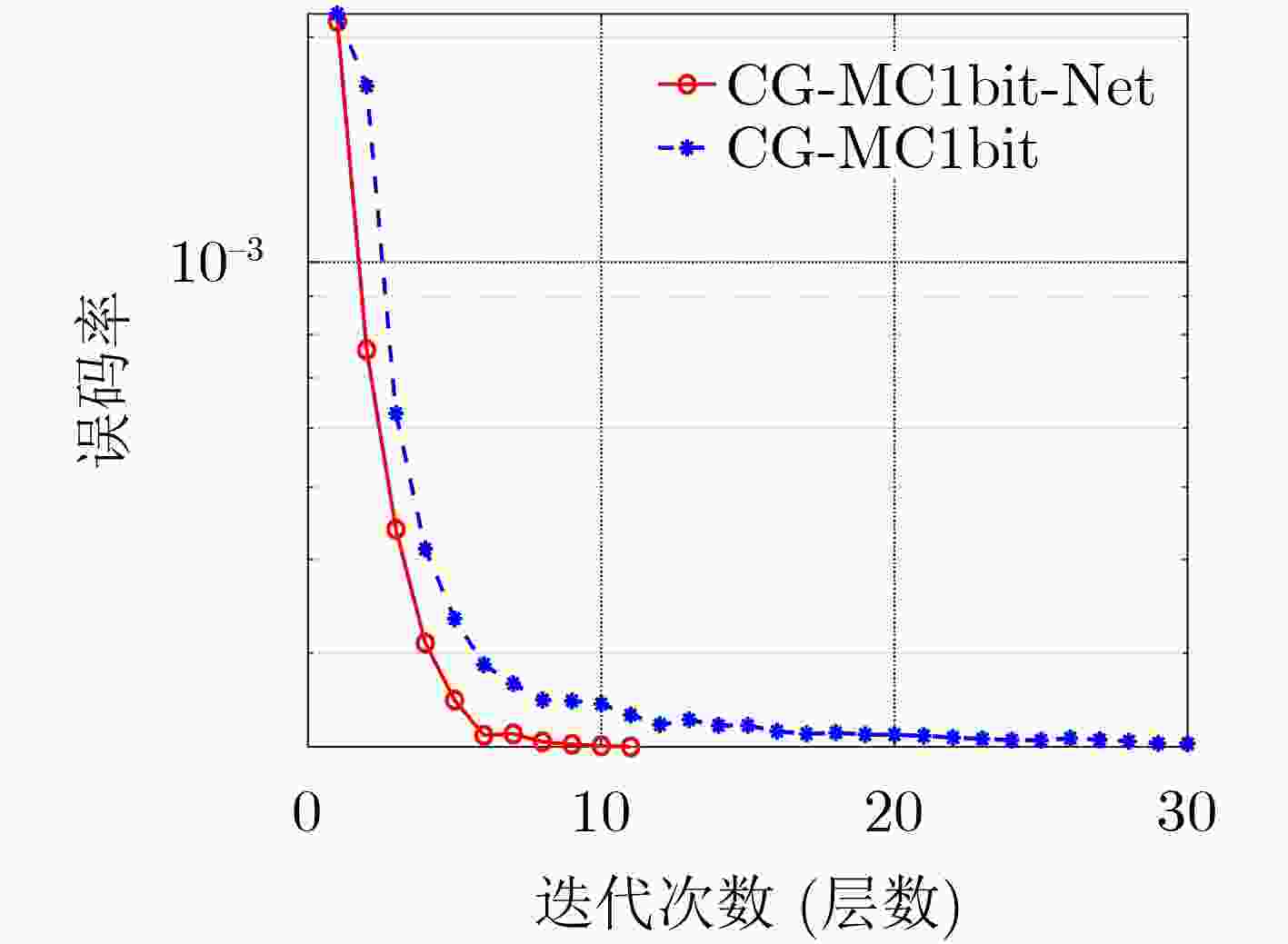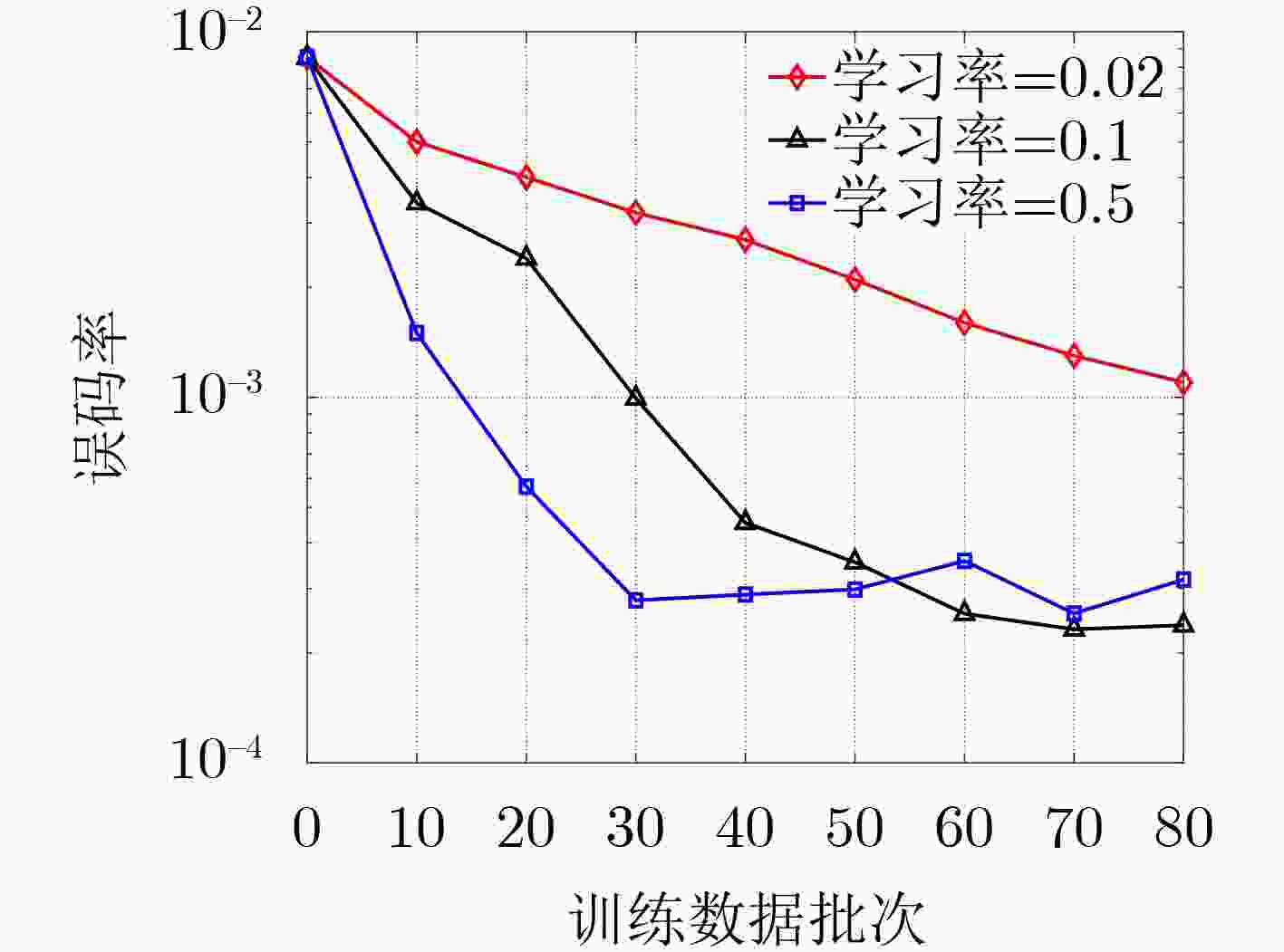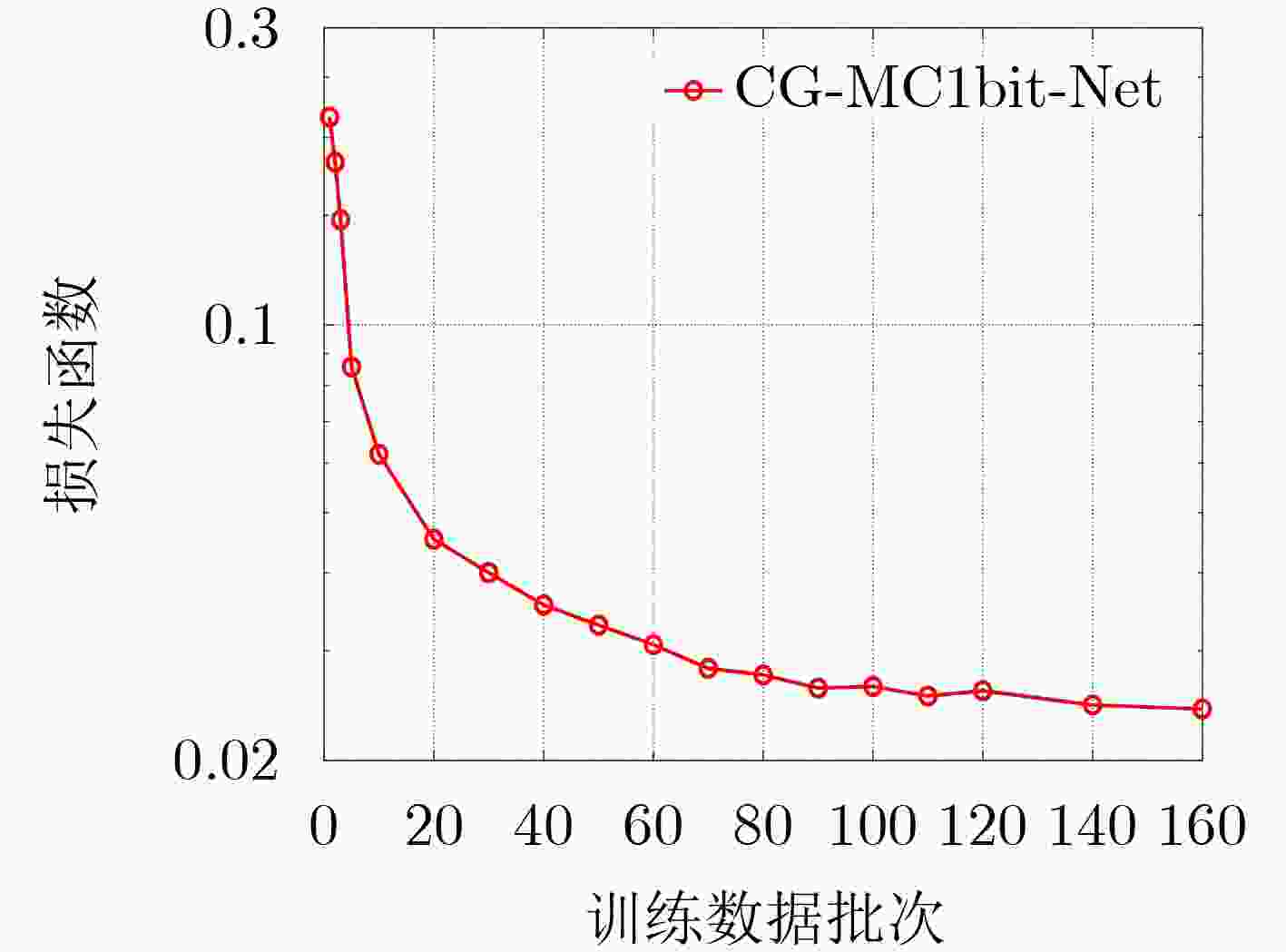1-bit Precoding Algorithm for Massive MIMO OFDM Downlink Systems with Deep Learning
-
摘要: 大规模多输入多输出(MIMO)系统中通过在基站端配备数百根天线,在提高频谱利用效率的同时,也带来了系统成本的增加。本课题组之前提出了一种适用于下行大规模MIMO正交频分复用(OFDM)系统的收敛保证的多载波1比特预编码算法(CG-MC1bit),能够获得较优的系统性能,但相应的计算复杂度较高,阻碍了其在实时系统中的应用。为进一步解决大规模MIMO系统中的成本和功耗问题,该文提出了一个模型驱动的神经网络,在CG-MC1bit算法的基础上迭代展开(Unfolding)得到了一种更加高效的CG-MC1bit-Net算法。具体而言,将迭代算法展开为一个神经网络,并引入可训练的参数来替代前向传播中的高复杂性操作。实验结果表明,该方法能够自动更新参数,与传统的预编码算法相比,收敛速度更快,计算复杂度更低。
-
关键词:
- 大规模多输入多输出 /
- 预编码 /
- 正交频分复用(OFDM) /
- 迭代展开 /
- 神经网络
Abstract: The base station of a massive Multiple-Input Multiple-Output (MIMO) system is equipped with hundreds of antennas, enhancing the spectral efficiency of the system and increasing the system costs. To address this problem, our research group proposed a Convergence-Guaranteed Multi-Carrier one-bit precoding (CG-MC1bit) iterative algorithm suitable for Orthogonal Frequency-Division Multiplexing (OFDM) downlink massive MIMO systems, which can ensure superior system performance. However, the corresponding computational complexity is high, hindering the practical application of the algorithm in real-time systems. To address this issue, we propose a model-driven, unfolding neural network, which is based on the CG-MC1bit iterative algorithm and introduces trainable parameters to replace high-complexity operations in forward propagation. In particular, we unfold the iterative algorithm into a neural network and introduce trainable parameters to replace high-complexity operations in forward propagation. Simulation results reveal that this method can automatically update parameters. In addition, compared with the traditional precoding algorithms, the proposed method has a higher convergence speed and lower computational complexity.-
Key words:
- Massive MIMO /
- Precoding /
- Orthogonal Frequency-Division Multiplexing(OFDM) /
- Unfolding /
- Neural Network
-
1 CG-MC1bit-Net算法
已知:传输信号矩阵$ {{\boldsymbol{S}}} $,信道矩阵$ {{\boldsymbol{H}}} $,神经网络层数$ K $ 1) 初始化 $ {\boldsymbol{X}}^{\text{0}}={{\bf{1}}},\;{\boldsymbol{R}}^{\text{0}}\text{=}{{\bf{1}}},\;{\boldsymbol{V}}^{\text{0}}={{ {\textit{0}}}},\;\alpha =\text{0}\text{.1} $ 2) for 数据集中的每个样本 do 3) 初始化$k = {\text{0}}$ 4) while $k < K$ do 5) ${\tilde {\boldsymbol{H}}} = {\alpha ^k}{{\boldsymbol{H}}}$ 6) 初始化$l = {\text{0}}$ 7) for $l < L$ do 8) 根据式(4)更新$ {{{\boldsymbol{x}}}^{k + 1}}[l] $,$ l = l + {\text{1}} $ 9) end for 10) $ {{\boldsymbol{R}}}_{\text{T}}^{k + 1} = \eta \tanh \left[ {\delta \dfrac{1}{L}\left( {{{{\boldsymbol{X}}}^{k + 1}} + \dfrac{1}{\lambda }{{{\boldsymbol{V}}}^k}} \right){{\boldsymbol{F}}}_L^{\text{H}}} \right] $ 11) $ {{{\boldsymbol{R}}}^{k + 1}} = {{\boldsymbol{R}}}_{\text{T}}^{k + 1}{{{\boldsymbol{F}}}_L} $ 12) $ {{{\boldsymbol{V}}}^{k + 1}} = {{{\boldsymbol{V}}}^k} + \lambda \left( {{{\boldsymbol{X}}}_{\text{T}}^{k + 1} - {{{\boldsymbol{R}}}^{k + 1}}} \right) $ 13) $ k = k + {\text{1}} $ 14) end while 15) 输出$ {{\boldsymbol{R}}}_{\text{T}}^K $,并根据式(11)计算损失函数$ {\text{los}}{{\text{s}}_{{\text{MSE}}}} $ 16) 执行会话 17) for 隐藏层或输出层的每个神经元 do 18) 更新网络中的每一个权值和偏差 19) end for 20) end for 表 1 运行速度对比
预编码算法 天线数128 天线数512 CG-MC1bit-Net 0.429 s 2.127 s CG-MC1bitx 3.47 s 10.33 s -
[1] BJÖRNSON E, SANGUINETTI L, HOYDIS J, et al. Optimal design of energy-efficient multi-user MIMO systems: Is massive MIMO the answer?[J]. IEEE Transactions on Wireless Communications, 2015, 14(6): 3059–3075. doi: 10.1109/TWC.2015.2400437. [2] LU Lu, LI G Y, SWINDLEHURST A L, et al. An overview of massive MIMO: Benefits and challenges[J]. IEEE Journal of Selected Topics in Signal Processing, 2014, 8(5): 742–758. doi: 10.1109/jstsp.2014.2317671. [3] RUSEK F, PERSSON D, LAU B K, et al. Scaling up MIMO: Opportunities and challenges with very large arrays[J]. IEEE Signal Processing Magazine, 2013, 30(1): 40–60. doi: 10.1109/msp.2011.2178495. [4] SAXENA A K, FIJALKOW I, MEZGHANI A, et al. Analysis of one-bit quantized ZF precoding for the multiuser massive MIMO downlink[C]. 2016 50th Asilomar Conference on Signals, Systems and Computers, Pacific Grove, USA, 2016: 758–762. doi: 10.1109/ACSSC.2016.7869148. [5] SWINDLEHURST A L, SAXENA K A, MEZGHANI A, et al. Minimum probability-of-error perturbation precoding for the one-bit massive MIMO downlink[C]. 2017 IEEE International Conference on Acoustics, Speech and Signal Processing, New Orleans, USA, 2017: 6483–6487. doi: 10.1109/ICASSP.2017.7953405. [6] CHU Lei, WEN Fei, LI L, et al. Efficient nonlinear precoding for massive MIMO downlink systems with 1-bit DACs[J]. IEEE Transactions on Wireless Communications, 2019, 18(9): 4213–4224. doi: 10.1109/TWC.2019.2920125. [7] CHEN Zhenhui, WANG Yajun, LIAN Zhuxian, et al. Low-complexity constant envelope precoding with one-bit DAC for massive MU-MIMO systems[J]. IEEE Wireless Communications Letters, 2021, 10(12): 2805–2809. doi: 10.1109/LWC.2021.3118202. [8] HAQIQATNEJAD A, KAYHAN F, SHAHBAZPANAHI S, et al. Finite-alphabet symbol-level multiuser precoding for massive MU-MIMO downlink[J]. IEEE Transactions on Signal Processing, 2021, 69: 5595–5610. doi: 10.1109/TSP.2021.3113803. [9] JACOBSSON S, CASTAÑEDA O, JEON C, et al. Nonlinear precoding for phase-quantized constant-envelope massive MU-MIMO-OFDM[C]. 2018 25th International Conference on Telecommunications (ICT), Saint-Malo, France, 2018: 367–372. doi: 10.1109/ICT.2018.8464896. [10] TSINOS C G, DOMOUCHTSIDIS S, CHATZINOTAS S, et al. Symbol level precoding with low resolution DACs for constant envelope OFDM MU-MIMO systems[J]. IEEE Access, 2020, 8: 12856–12866. doi: 10.1109/ACCESS.2019.2963857. [11] WEN Liyuan, QIAN Hua, HU Yunbo, et al. One-bit Downlink precoding for massive MIMO OFDM system[J]. IEEE Transactions on Wireless Communications, 2023, 22(9): 5914–5926. doi: 10.1109/TWC.2023.3238380. [12] ZHANG Shangwei, LIU Jiajia, RODRIGUES T K, et al. Deep learning techniques for advancing 6G communications in the physical layer[J]. IEEE Wireless Communications, 2021, 28(5): 141–147. doi: 10.1109/MWC.001.2000516. [13] LIU Zhenyu, DEL ROSARIO M, and DING Zhi. A Markovian model-driven deep learning framework for massive MIMO CSI feedback[J]. IEEE Transactions on Wireless Communications, 2022, 21(2): 1214–1228. doi: 10.1109/TWC.2021.3103120. [14] ZHANG Xinliang and VAEZI Mojtaba. Multi-objective DNN-based precoder for MIMO communications[J]. IEEE Transactions on Communications, 2021, 69(7): 4476–4488. doi: 10.1109/TCOMM.2021.3071536. [15] HE Hengtao, ZHANG Mengjiao, JIN Shi, et al. Model-driven deep learning for massive MU-MIMO with finite-alphabet precoding[J]. IEEE Communications Letters, 2020, 24(10): 2216–2220. doi: 10.1109/LCOMM.2020.3002082. [16] BALATSOUKAS-STIMMING A, CASTAÑEDA O, JACOBSSON S, et al. Neural-network optimized 1-bit precoding for massive MU-MIMO[C]. 2019 IEEE 20th International Workshop on Signal Processing Advances in Wireless Communications (SPAWC), Cannes, France, 2019: 1–5. doi: 10.1109/SPAWC.2019.8815519. [17] HU Qiyu, CAI Yunlong, SHI Qingjiang, et al. Iterative algorithm induced deep-unfolding neural networks: Precoding design for multiuser MIMO systems[J]. IEEE Transactions on Wireless Communications, 2021, 20(2): 1394–1410. doi: 10.1109/TWC.2020.3033334. [18] 蒋伊琳, 尹子茹, 宋宇. 基于卷积神经网络的低截获概率雷达信号检测算法[J]. 电子与信息学报, 2022, 44(2): 718–725. doi: 10.11999/JEIT210132.JIANG Yilin, YIN Ziru, and SONG Yu. Low probability of intercept radar signal detection algorithm based on convolutional neural networks[J]. Journal of Electronics & Information Technology, 2022, 44(2): 718–725. doi: 10.11999/JEIT210132. [19] ZHANG Kai, VAN GOOL L, and TIMOFTE R. Deep unfolding network for image super-resolution[C]. 2020 IEEE/CVF Conference on Computer Vision and Pattern Recognition (CVPR), Seattle, WA, USA, 2020: 3214–3223. doi: 10.1109/CVPR42600.2020.00328. [20] SAMUEL N, DISKIN T, and WIESEL A. Deep MIMO detection[C]. 2017 IEEE 18th International Workshop on Signal Processing Advances in Wireless Communications (SPAWC), Sapporo, Japan, 2017: 1–5. doi: 10.1109/SPAWC.2017.8227772. [21] HUBARA I, COURBARIAUX M, SOUDRY D, et al. Binarized neural networks[C]. Proceedings of the 30th International Conference on Neural Information Processing Systems. Red Hook, USA, 2016: 4114–4122. [22] QIN Haotong, GONG Ruihao, LIU Xianglong, et al. Forward and backward information retention for accurate binary neural networks[C]. 2020 IEEE/CVF Conference on Computer Vision and Pattern Recognition (CVPR), Seattle, USA, 2020: 2247–2256. doi: 10.1109/CVPR42600.2020.00232. -






 下载:
下载:









 下载:
下载:
